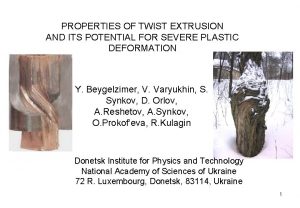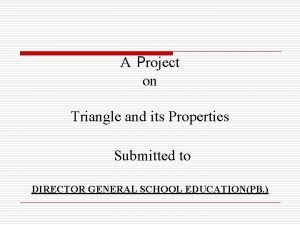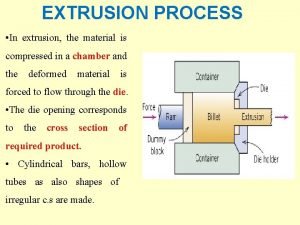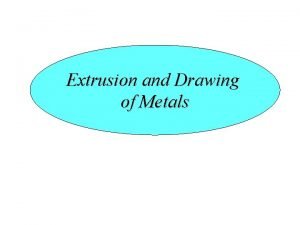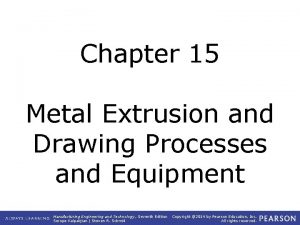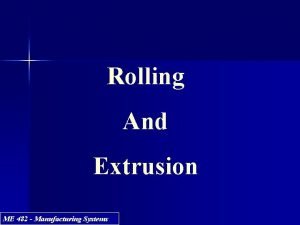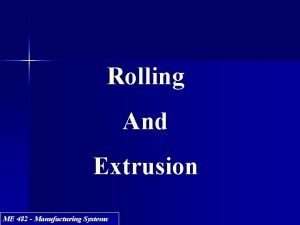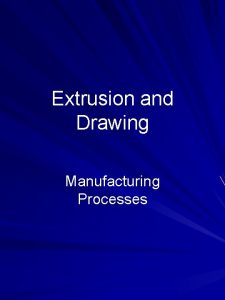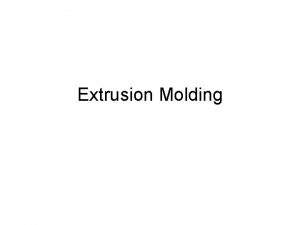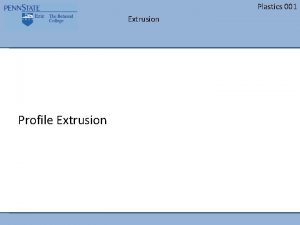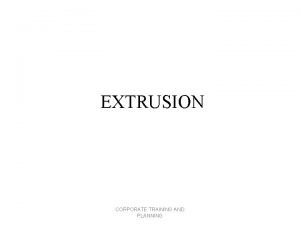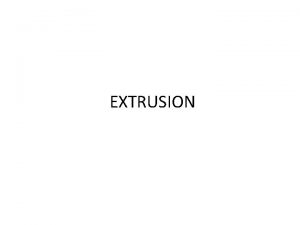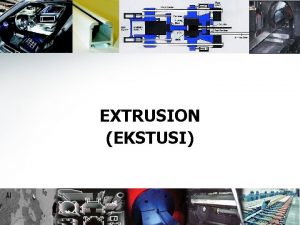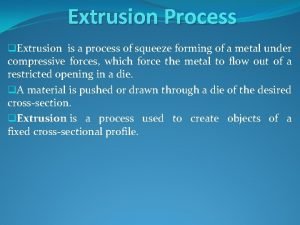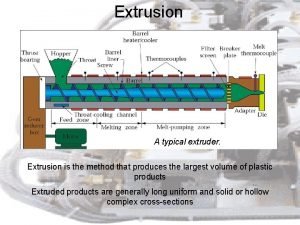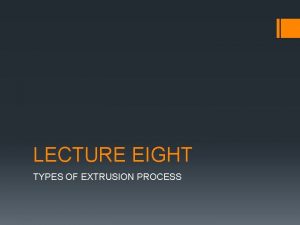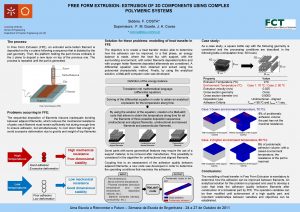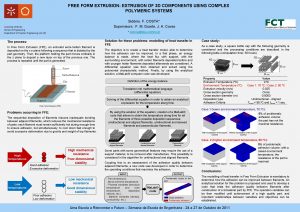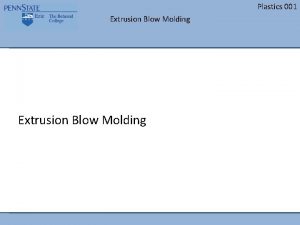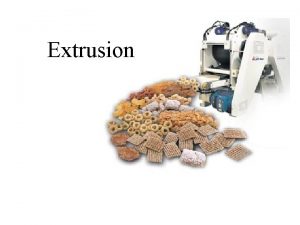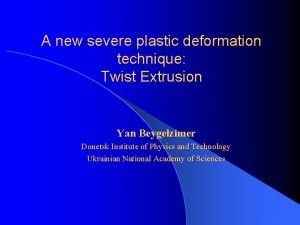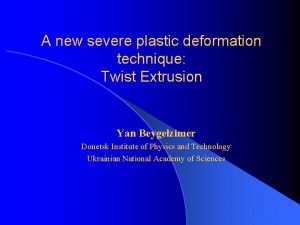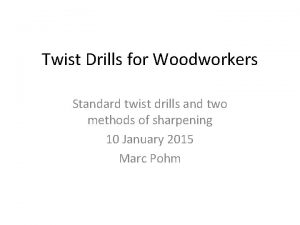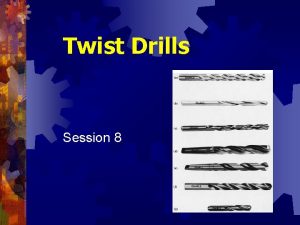PROPERTIES OF TWIST EXTRUSION AND ITS POTENTIAL FOR







































- Slides: 39

PROPERTIES OF TWIST EXTRUSION AND ITS POTENTIAL FOR SEVERE PLASTIC DEFORMATION Y. Beygelzimer, V. Varyukhin, S. Synkov, D. Orlov, A. Reshetov, A. Synkov, O. Prokof’eva, R. Kulagin Donetsk Institute for Physics and Technology National Academy of Sciences of Ukraine 72 R. Luxembourg, Donetsk, 83114, Ukraine 1

Twist Extrusion: Why care? Kinematics of TE is substantially different from that of other SPD processes (like ECAP and HPT). New potential for investigating and forming new structures with new properties. 2

Experimental investigation of TE kinematics 1. We used experimental vizioplasticity method (E. G. Thomsen). Metal flow were reconstructed from cross-sections of the specimen with fibres stopped in the die. 2. We refined this method by incorporating two natural conditions: -metal volume remains constant; -metal flow is limited by the surface of the die. 1 5 25 30 Advantage: method takes into account the actual rheology of metal and real friction conditions. 3

Main Findings • As in HPT and ECAP, deformation in TE is performed through simple shear. • There are multiple shear planes, unlike in HPT and ECAP. These planes are perpendicular and parallel to the specimen axis. • There are vortex flow with stretching and mixing within the deformation centre • There are four well defined deformation zones with different properties of metal flow 4

Deformation Zones 1 and 2 Located at the two ends of the twist part of the die. Simple shear in the Transversal plane (T) as in HPT. T Shears in zones 1 and 2 have opposite direction. T T T 1 2 Strain: from e ~ 0. 0 on the axis to e ~ 1. 0 ÷ 1. 5 on the periphery 5

Strain accumulation Zones 1 and 2 Cu, 20 o. C 2 1 Strain accumulation along the die in a characteristic point where zones 1 and 2 are responsible for most of the deformation. 6

Deformation Zone 3 Located in the twist part of the die between zones 1 and 2 Simple shear in the rotating Longitudinal plane (L) = 250 300 3 =250 300 Strain: e ~ 0. 4 0. 5 L 2 1 L 7

Strain accumulation Zones 3 Cu, 20 o. C 3 Strain accumulation along the die in central point where zone 3 is responsible for the deformation. 8

Deformation Zone 4 Located in the twist part of the die between zones 1 and 2 Simple shear in the peripheral layer (1÷ 2 mm thick) Al-0. 13%Mg 4 Al-0. 13%Mg Strain: e ~ 2 We thank Dr. Berta (University of Manchester, UK) for macrostructures b), c) 9

Cu, 20 o. C Strain accumulation Zone 4 4 Strain accumulation along the die in a peripheral point 10

Accumulation Strain at TE (Cu, 20 o. C) 11

Controlling metal flow in TE Strain distribution and deformation zones boundaries strongly depend on • the geometry of die’s cross-section, • inclination angle • rotation angle By varying these parameters, one can obtain given inhomogeneous strain. This is of interest for (1) investigating the effects of strain gradient on the evolution of material structure, as well as (2) obtaining gradient structures. 12

Accumulation strain for 1 pass TE (Cu, 20 o. C) =50 o, =80 o =35 o, =80 o =50 o, =80 o 13

Smoothing of structure and properties during maltipass TE Despite the nonuniformity of deformation, subsequent TE typically leads to uniform structure and properties. This is due to (1) mixing of metal and (2) stabilization of structure and saturation of properties if strain becomes greater than saturation level es 0, 2 , МPа Cu 99, 9% After 2 passes After 4 passes Mean Min Max Range 419 385 462 77 (18%) 426 403 450 47 (11%) Joint work with Dr. Korshunov, Sarov, Russia 14

Stabilization of structure and saturation of properties during TE es es 99. 9%Cu 99. 99% Al Joint work with Dr. Korshunov, Sarov, Russia 1 TE pass 4 TE passes 15 Joint work with Prof. Horita, Kyushu University, Fukuoka, Japan

Zone where strain is above the saturation threshold es=2 (1 pass) e 16

Zone where strain is above the saturation threshold es=2 (2 pass) e 17

Zone where strain is above the saturation threshold es=2 (3 pass) e 18

Zone where strain is above the saturation threshold es=2 (4 pass) e 19

Zone where strain is above the saturation threshold es=2 (5 pass) e 20

Two main routes of TE Two orientations of the die ( , ) lead to two main routes of TE CD Route I: CD+CD CD CCD Route II: CD+CCD CD-clockwise die CCD- counterclockwise die 21

Two main routes of TE Route I: CD+CD Route II: CD+CCD Plane T T 2 A A L L Plane L 0 1 Number of passes 2 22

Route II overcomes saturation CP-Ti (grade 2) 300 o. C =45 o Route I , Route II , Different loading paths can lead to different structures and properties. In particular, using route II allows one to increase the yield threshold of Ti after it saturates in route I Joint work with Prof. Rack, Clemson University, USA 23

Vortex and Mixing Deformation Zones 3 and 4 form a vortex-like flow which stretches metal particles. perpendicular cross-section The stretching increases with subsequent TE passes as long as the dies have a constant direction (all clockwise or all counterclockwise) 24

Stretching (initial) 25

Stretching Вытягивание (1 pass, counter-clockwise die) 26

Stretching Вытягивание (2 passes, counter-clockwise die) 27

Stretching Вытягивание (3 passes, counter-clockwise die) 28

Passes with alternating directions create folds CD CCD , 2 mm We thank Dr. Milman for sharing the microstructure. 29

At a finer scale, folds form due to instability of shear planes Initial After one pass TE Aluminum Joint work with Prof. Milman, Kiev, Ukraine 30

Alternating stretching and folding leads to mixing, as in Smale’s horseshoe Initial specimen stretching After several passes folding Final specimen 31

So why should we care about Twist Extrusion? 32

• TE has already been successfully used to obtain UFG structure with good properties in Al, Cu, Ni and Ti alloys (more at http: //hunch. net/~yan). • Most importantly, TE opens new possibilities for investigating and forming new structures with new properties, mainly due to four factors. 33

Factor 1: Two new shear planes in the volume of the specimen T L TE ECAP 34

Factor 2: Vortex-like flow with stretching and mixing of metal particles This is of interest for (1) homogenization (2) mechanochemical reactions 35

Factor 3: Two main routes of TE which can be combined with any SPD or metal forming processes (for example: ECAP, rolling, extrusion) to broaden the space of possible loading paths. ECAP TE A I B C II BA BC 36

Factor 4: New technological possibilities ECAP TE Obtaining profile or Metal waste reducing hollow specimen Twist die F 37

We hope that TE will find its place among other SPD techniques 38

We hope that TE will find its place among other SPD techniques If anyone wants to talk about TE, tean@an. dn. ua 39
 Twist extrusion
Twist extrusion Graded potential and action potential
Graded potential and action potential Define electric potential and potential difference.
Define electric potential and potential difference. Electric potential energy
Electric potential energy Water potential definition biology
Water potential definition biology Sales potential vs market potential
Sales potential vs market potential Electric potential
Electric potential Electric potential and electric field
Electric potential and electric field V = pe/q
V = pe/q Electric potential
Electric potential Why is water potential measured in pascals
Why is water potential measured in pascals ψs
ψs Graded potential vs action potential
Graded potential vs action potential Graded potential vs action potential
Graded potential vs action potential Graded potential vs action potential
Graded potential vs action potential Graded potential vs action potential
Graded potential vs action potential Water potential
Water potential Source of bioelectric potential is dash in nature
Source of bioelectric potential is dash in nature Hypopolarization
Hypopolarization Succinylcholine dose
Succinylcholine dose Action potential resting potential
Action potential resting potential Action potential resting potential
Action potential resting potential Electric field lines
Electric field lines Structure of emigree
Structure of emigree Its halloween its halloween the moon is full and bright
Its halloween its halloween the moon is full and bright Matter and its properties
Matter and its properties Project file on triangles class 10
Project file on triangles class 10 Lesson 6: trapezoids and kites
Lesson 6: trapezoids and kites Extensive examples
Extensive examples Physical and chemical properties
Physical and chemical properties Deep impact extrusion
Deep impact extrusion Extrusion ratio
Extrusion ratio Extrusion vs drawing
Extrusion vs drawing Rolling and extrusion
Rolling and extrusion Rolling and extrusion
Rolling and extrusion Extrusion and drawing
Extrusion and drawing Kontinuitetshantering i praktiken
Kontinuitetshantering i praktiken Novell typiska drag
Novell typiska drag Tack för att ni lyssnade bild
Tack för att ni lyssnade bild Returpilarna
Returpilarna
